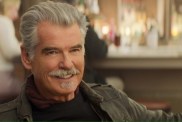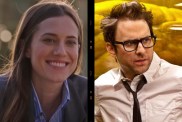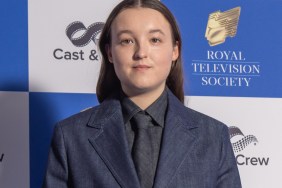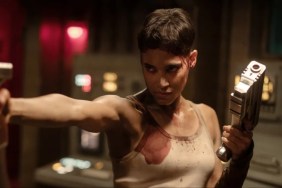Opening Friday, January 18th

Cast:
Michael Stahl-David as Rob Hawkins
Mike Vogel as Jason Hawkins
Jessica Lucas as Lily Ford
T.J. Miller as Hud Platt
Lizzy Caplan as Marlena Diamond
Odette Yustman as Beth McIntyre
Directed by Matt Reeves
Review:
Questions have surrounded the release of “Cloverfield,” the much-heralded meta-monster pic that tracks a massive creatureâs Manhattan attack from the perspective of a household handicam, since word of the film first crawled into the public consciousness last summer. What is this semi-serpentine, ostensibly sea-borne beast? Where, exactly, does it come from? How was this purportedly “found footage” obtained, and what fate ultimately befell those who filmed it? While these sorts of issues would be the crux of most big monster flicks, here the answers are elusive, as is typical for a production from J.J. Abrams (the puppet master pulling the complex strings of TV’s “Lost”). Gone, too, are the handsome, wholesome scientists and tight-jawed generals that usually save our cities from a creature’s assault. In their place, Abrams and director Matt Reeves offer us a modern take on the monster-run-amok genre more concerned with how average peeps like you and me deal with such destruction â an approach that’s alternately terrifying and troubled.
“Cloverfield” sputters to life with the morning-after musings of Rob (the perpetually scruffy Michael Stahl-David) and Beth (Odette Yustman) as documented on Rob’s digital video camcorder. The two exchange awkward pillow talk and plot out a visit to Coney Island, but the record of their trip is interrupted when Rob’s brother and friends commandeer the camera â and the tape â to film a surprise party they’re throwing for him before he jets off to Tokyo (where else but Godzilla’s old hood?). Rob’s friend Hud mans the camera and seeks out farewell testimonials from the party guests, but this isn’t quite the monster bash everyone was expecting. The soiree is cut short when explosions rock the lower east side and the Statue of Liberty’s severed head shows up in the street, the victim of a titanic monstrosity now stampeding across NYC. As the masses flee, Rob attempts to contact Beth, learns she is trapped in her midtown apartment, and resolves to get her out. Backed by a close handful of friends, Rob’s journey leads from one dangerous destination to another, from creature-infested subways to the top floors of a teetering highrise â and we’re along for every harrowing moment through the lens of Rob’s camera.
VeritÃ-style, “guerrilla” video is nothing new to horror; between the steadicam stalking of early slashers like “Black Christmas” and “Halloween” and the stomach-churning cinematography of “The Blair Witch Project,” the genre practically invented the POV technique. But this is the first time a first-person approach has been applied to a concept of such massive scale. Where other films of this stripe rely on brazen spectacle and sweeping views, “Cloverfield” tightens its cinematic eye and concentrates on terror at a personal level, never leaving the ground unless its central characters do, resulting in a heightened sense of intensity and immediacy each time Rob and his companions are threatened. What transpires isn’t necessarily scarier than what we’ve seen in past monster pics, nor is the monster any more believable â it just hits us on an entirely different level. The monster is not even around in the film’s most chilling and affecting moments, when, as buildings crumble and dust fills the air, puzzled New Yorkers pour into the streets and grasp at explanations for what they’ve just witnessed. The shock and panic induced by a lack of knowledge or understanding about what’s happening (obviously evoking horrors that are all too real) is what “Cloverfield’s” gimmick captures best.
But no matter how transcendent its approach may be, a first-person film’s story is only as compelling as the people through whom we experience it, and in “Cloverfield” those people are a problem. “Cloverfield’s” cast of glossy urban hipsters may be less common than the stock scientists and military brass that make up most monster flicks, but that doesn’t mean they’re any more interesting or entertaining. To be fair, director Reeves makes good use of these twenty-nothings at the film’s outset, lulling us into submission in his party footage. With each vapid video diary we’re forced to endure, we grow increasingly numb to the proceedings â leaving us utterly unprepared when the festivities are halted by a cataclysmic explosion and the plastic party atmosphere disintegrates into chaos.
Still, in committing to Rob and his friends for the rest of the film, Drew Goddard’s screenplay saddles us with a bunch of underdeveloped stiffs from a Bacardi commercial as our guides through this unfolding nightmare, and they quickly grow tedious. We may believe in them enough to buy into their friendship (arguably), but we’re given little incentive to come along on Rob’s pseudo-chivalrous quest to save Beth. While the monster’s presence is enough to overcome the shortcomings of the script, for a portion of the film we are pulled away from the creature’s rampage without a satisfying substitute as Rob and his friends seek refuge and safe passage in New York’s subway system. What they discover in the tunnels may be ferocious, but it feels derivative and distracts us from the essence of the film. This is a movie about a giant monster, after all, and we want to be where it is and learn more about it.
While little about the monster is explained outright, clues and theories regarding its origin are dropped throughout, and the film gives us just enough sense of its physiology to know that it’s nasty and nearly indestructible, without lingering on the so-so CGI for too long â until the last few moments, at least. It may lack the personality of other famous city-smashing beasts, but it’s arguably unmatched as a terrifying force of widespread devastation.
Likewise, though it’s difficult to judge whether “Cloverfield” lives up to its hype (to this reviewer, the hype and all of the viral hints used to market it are essentially two heads of the same beast), the film undeniably delivers what it promises in taking us through familiar stomping grounds in a way we’ve never been before. Abrams and his production team succeed where others have failed (and when I say “others,” I’m talking about a couple of guys named Devlin and Emmerich), creating a movie that fits perfectly within the pantheon of giant monster flicks while simultaneously taking it to a new, viable, culturally relevant level. I’d say that’s worth a little roaring, wouldn’t you?










